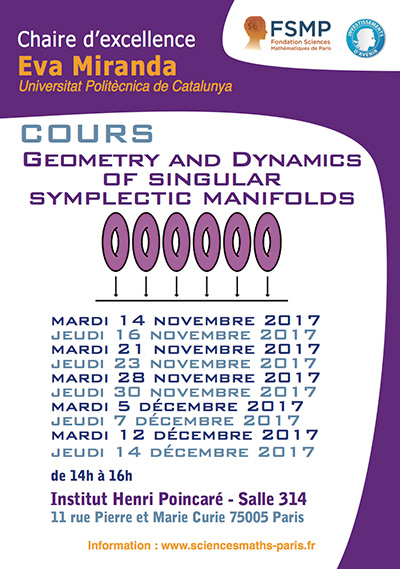Geometry and Dynamics of singular sympletic manifolds
Eva Miranda (Universitat Politècnica de Catalunya) (Sa page personnelle), lauréate de la Chaire d'excellence de la FSMP en 2017, accueillie au CEREMADE et à l'IMCCE et en collaboration avec le LAGA et l'IMJ, a donné dans le cadre de sa chaire un cours intitulé Geometry and Dynamics of singular symplectic manifolds.
Résumé du cours
b‑Calculus was introduced by Richard Melrose when considering pseudodifferential operators on manifolds with boundary. Later on, Ryszard Nest and Boris Tsygan applied these ideas to study the deformation quantization of symplectic manifolds with boundary.
The purpose of this minicourse is to unravel the geometrical structures (b‑symplectic structures) behind this picture and describe some applications to Dynamical systems. b‑Symplectic manifolds are Poisson manifolds which are symplectic away from an hypersurface and satisfy some transversality condition. b‑Symplectic manifolds lie "close enough" to the symplectic category and indeed their study can be addressed using an "extended" De Rham complex. In particular many peculiarities from Symplectic manifolds are shared with b‑symplectic manifolds. Using these ideas, we will study normal form theorems, action‑angle theorems, toric actions and applications to KAM theory. At the end of the minicourse we present other singular symplectic structures such as folded symplectic structures and bm‑symplectic structures (for which the transversality condition is relaxed) and explain how they are related to b‑symplectic and symplectic structures.
We will give a general overview of the theory using some examples in celestial mechanics as leitmotiv. For some of them (like double collision), we can even construct bm‑symplectic structures and m‑folded structures. This apparent "duality" will be used as an excuse to closely explore the relation between the bm‑symplectic category with the symplectic and folded symplectic category. This relation depends surprisingly on the parity of m and is given by a desingularization procedure called deblogging. Time permitting, several applications of deblogging to dynamics and quantization will be presented.
Vidéo des cours
Cours # 1
Cours # 2
Cours # 3
Cours # 4
Cours # 5
Cours # 6
Cours # 7
Cours # 8
Cours # 9
Cours # 10
Affiche du cours

When you subscribe to the blog, we will send you an e-mail when there are new updates on the site so you wouldn't miss them.


